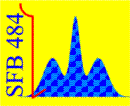
Second International Workshop 2004
Ordering Phenomena in Transition Metal Oxides
September 26 - 29, 2004, Wildbad Kreuth
|
Welcome Pictures taken at the Workshop Invited Speakers Program Poster Session Social Program Organization Technical Information Travel Information Weather SFB 484 Institute of Physics |
|
Invited Talk
|
|
| W. Hanke (Würzburg), Z. B. Huang, E. Arrigoni, and D. J. Scalapino | |
|
Are the electron-phonon and the spin-fluctuation mediated pairing potentials enhanced or suppressed by vertex corrections?
|
|
|
The effects of electronic correlations on the electron-phonon
(el-ph) and on the electron-spin-fluctuation (el-sp) coupling are
studied in a two-dimensional Hubbard model as a function of doping
and temperature. The el-ph and el-sp vertices, which enter the
corresponding boson mediated pairing potentials and which influence
much-discussed issues such as the ``kinks'' in photoemission
spectra, are extracted on the basis of a numerically exact quantum
Monte-Carlo (QMC) technique and complimented with a diagrammatic
analysis. Entering, in the case of the el-ph vertex, the physically
relevant strong-correlation regime (U ≅ 8t), we find that the
forward scattering process (i. e. for small phonon momenta q,
ionic el-ph coupling) stops decreasing and begins to substantially
increase as a function of U, leading to an effective el-ph
coupling which is peaked in the forward direction. Whereas at weak
and intermediate Coulomb interactions, screening is the dominant
correlation effect suppressing the el-ph coupling, at larger U
values irreducible vertex corrections become more important and give
rise to this increase. These vertex corrections are shown to
crucially depend on the renormalized electronic structure of the
strongly correlated system. Our findings deviate from a Fermi-liquid
description and, in contrast to approximate analytical (U = ∞)
and slave-boson results are not connected to an incipient transition
towards a charge instability or phase separation. Implications for
the specific role of phonon modes, for the el-ph mediated d-wave
pairing potential and ARPES selfenergy, and for the difference
between transport and superconducting el-ph coupling constants are
discussed. With a similar QMC approach, we have studied
whether the spin-fluctuation mediated pairing is suppressed by
vertex corrections, as has previously been suggested by
J. R. Schrieffer in the limit of large antiferromagnetic (AF)
correction length ξ. There remains the crucial question of how
large must ξ be for this effect to be substantial. We find that
both the vertex and thus also the el-sp pairing potential are
reduced already at very short ξs (of order Cu-Cu distance),
namely as soon as the relevant electronic states form ``spin-bag''
quasiparticles.
|
|
|
previous / next - Invited Speakers - Program |
|
| [ 21-Apr-17 ] | [ http://www.physik.uni-augsburg.de/sfb484/Kreuth2004/abstracts/hanke.shtml ] |